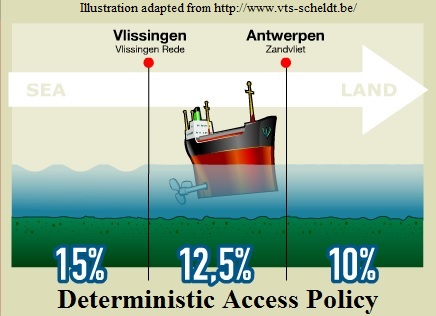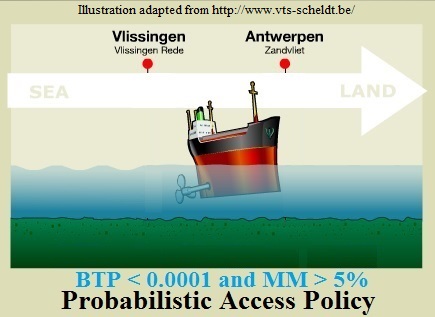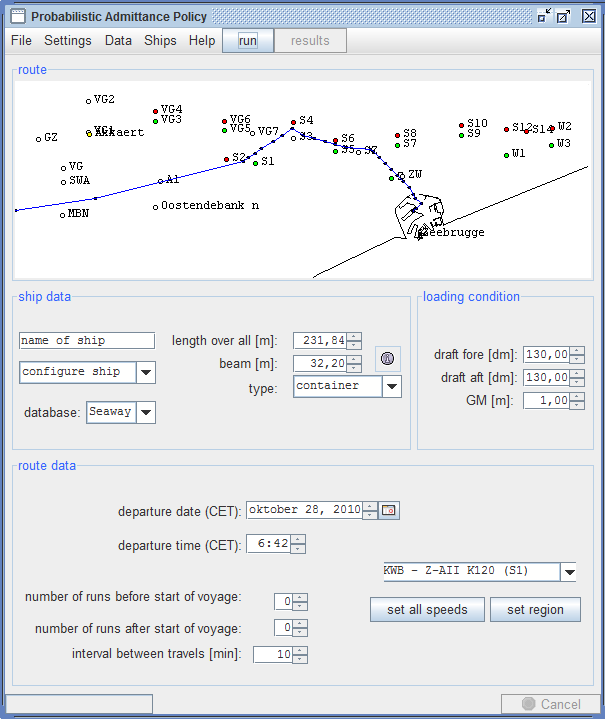Access Policy and Simulation Studies
Nautical screenings
Researchers of the Knowledge Centre have recently participated in two so-called nautical screenings. These nautical screenings are a small part of complex infrastructure projects, which follow an integrated methodology outlined by the Flemish Government. The objective is to achieve results within a reasonable amount of time, while simultaneously involving the society at large. The progress of these projects can be consulted by everybody on the dedicated project websites.
The first project looks for improved access to the hinterland of the Port of Zeebrugge. Shipping traffic at present passes solely through the Pierre Vandammelock, the older Visart lock being obsolete. Due to maintenance requirements, the Pierre Vandammelock will not be accessible in the near future. Several possible locations for a new lock were therefore evaluated by means of real time simulations by researchers of the Knowledge Centre in close collaboration with coastal and docking pilots and tugboat captains. A car carrier, with a length of 265 m and a width of 40 m, manoeuvring in wind conditions of 5 Bf, thus requiring constant tugboat assistance, was selected for this case study. The nautical screening is ongoing, but it is already clear that each location has its advantages and disadvantages.
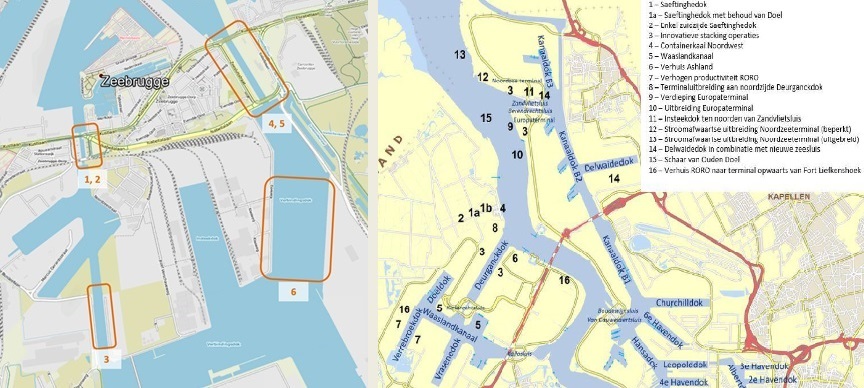
The second project is concerned with a nautical screening of suitable locations for new container terminals in the Port of Antwerp. The new terminals are very important in the development to enlarge the container handling capacity of the port with 7 million TEU by 2030. A desk study is being carried out by a team of expert members, composed of researchers of the Knowledge Centre and representatives of the river and docking pilots. The manoeuvring options of a selected design ship are investigated, along with the traffic characteristics for a fleet of ships. The design ship is a container carrier of the future with a length of 430 m and a breadth of 62 m. Several criteria are taken into account, such as the impact of wind, current and tide, turning and mooring manoeuvres, and the passing of locks and moored ships.
Access Policy: ProToel
The shipping traffic to the Belgian and Dutch ports located at the Western Scheldt estuary and the river Scheldt follows an access channel of which the depth is restricted. As a result, deep-drafted vessels cannot always sail 24 hours a day on the River Scheldt. The period in which these vessels may proceed inward or outward bound is called the tidal window, depending on the ship's draft and the height of the tide.
The Common Nautical Authority calculates these tidal windows and gives permission for the vessels to proceed in- or outbound. A so-called deterministic access policy is based on calculations that use tide, current (for example applicable to the Port of Zeebrugge), draft and water depth values to check whether a certain minimum gross under keel clearance is assured during the voyage and contact with the bottom is avoided at all times.
A probabilistic access policy, on the other hand, is based on an acceptable probability of bottom touch during the transit of any (deep-drafted) vessel and could therefore result into a more optimal use of the access channel.
The draft of a ship that is underway is not static. Depending of the speed, the ship will squat, which is a combination of sinkage and trim. In addition, a ship will respond to waves and wind so that the rolling, pitching and heaving motions will also affect the draft and hence the probability of touching the bottom (BTP).
A probability of bottom touch criterion needs to be accompanied by an additional criterion to guarantee the manoeuvrability and controllability of the vessel, as these properties are significantly affected with decreasing under keel clearance. Such a criterion can be formulated in terms of a minimum manoeuvring margin (MM).
Over the last couple of years, the Knowledge Centre has studied how the tidal windows are affected by adopting a probabilistic rather than deterministic access policy. A dedicated software package called ProToel was used in these studies. ProToel allows a user to select a ship with a specific loading condition, a route to be followed with a specified speed profile along the trajectory, and a specific starting time (or a series of starting times) for the voyage. In each point of the trajectory, the program calculates the gross under keel clearance based on bottom depth and water level data.
ProToel uses a databank of vessel motion characteristics that has been assembled with the aid of model tests and numerical calculations with Seaway and Aqua+. This database has been expanded to include vessels with a length of 400 m (E- type of Maersk Sealand). Historic information for currents, astronomical tides and wave spectra have been stored locally for fast computations. It is also possible to retrieve predictions of current, tides and wave spectra from a server and to use these during the calculations.
The study was carried out for 683 tidal cycles of the year 2011 and it was found that a probabilistic access policy results in a clear increase of the accessability of the ports involved, both in terms of length of tidal window and maximum allowable draft. Only in less than 5% of the tidal cycles the tidal windows will be smaller than when calculated with a deterministic access policy. The detailed findings of this study will be presented at the upcoming PIANC World Congress.
For more information on the concept of a tidal window, please consult the animation on the website of the Common Nautical Authority.
Development of a squat formula for bulk carriers
Earlier research performed by the Knowledge Centre had revealed that the ship squat has a significant impact on the duration of the tidal windows when applying probabilistic criteria. In order to predict the squat as accurately as possible, the Common Nautical Authority asked the Knowledge Center to develop a squat formula for cape size bulk carriers sailing inbound to the port of Flushing. The study was restricted to cape size bulk carriers because of their limited variety in hull shape and draft and the negligible influence of propulsion on the maximum squat of these full ship types that trim by the bow. The sailing area was limited to Flushing (the most downstream port on the River Scheldt) so that the variety of water density along the trajectory could be neglected.
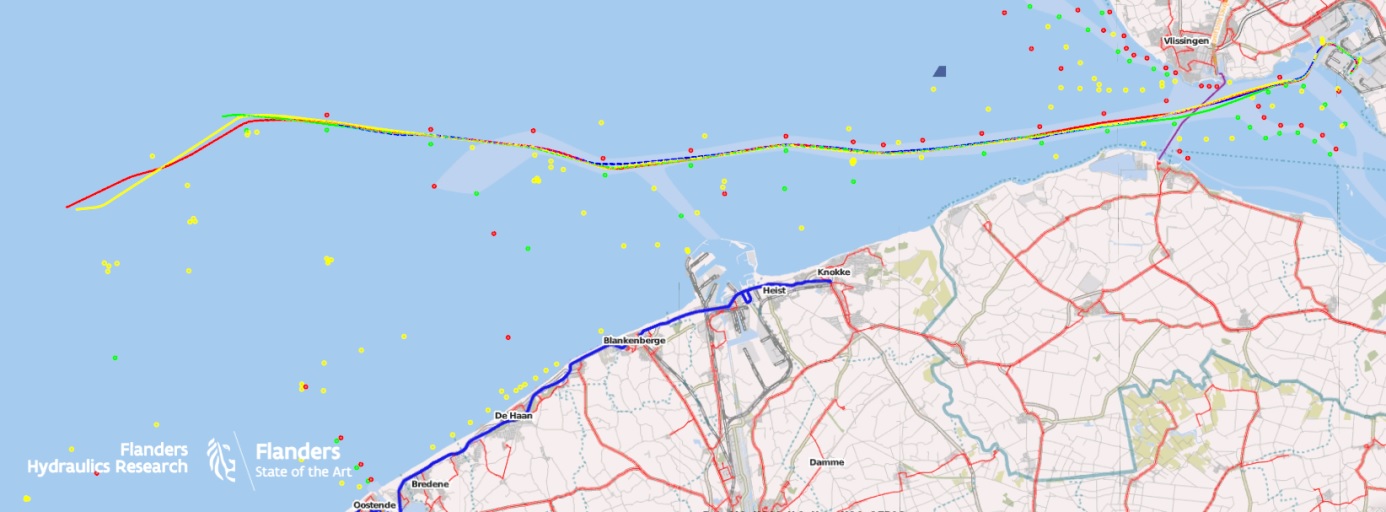
In the first phase of the project, a robust squat formula was developed based on captive towing tank measurements with a 1:70 scale model of a cape size bulk carrier at draft 16.5 m. The towing tank tests revealed that the squat by the bow is influenced by the ship speed, the under keel clearance and the blockage (which is the ratio of the midship section of the ship to the cross-sectional area of the waterway).
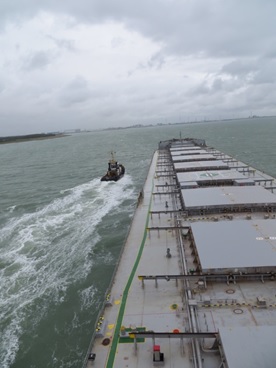 In the second phase of the project, the squat formula derived from the towing tank tests was compared to onboard squat measurements. The full scale measurements were provided by the Dutch Pilotage by means of positioning data from three RTK-GPS antennae that where mounted on both bridge wings and at the bow. The Knowledge Centre processed these data to motions of the vessel in 6 degrees of freedom. By referring the ship motions to a static measurement (at near-zero speed), the ship squat could be derived. The main challenge during squat measurements in a tidal environment, is the accurate determination of the water level along the trajectory. It turned out that processing based on a combination of hindcast current calculations performed by Rijkswaterstaat and tide measurements supplied both by Flemish and Dutch authorities led to an accurate result.
In the second phase of the project, the squat formula derived from the towing tank tests was compared to onboard squat measurements. The full scale measurements were provided by the Dutch Pilotage by means of positioning data from three RTK-GPS antennae that where mounted on both bridge wings and at the bow. The Knowledge Centre processed these data to motions of the vessel in 6 degrees of freedom. By referring the ship motions to a static measurement (at near-zero speed), the ship squat could be derived. The main challenge during squat measurements in a tidal environment, is the accurate determination of the water level along the trajectory. It turned out that processing based on a combination of hindcast current calculations performed by Rijkswaterstaat and tide measurements supplied both by Flemish and Dutch authorities led to an accurate result.
In addition to the squat, the ship speed trough water was determined based on position measurements and hindcast calculations of the current. The under keel clearance and the blockage were also determined, based on the most recent survey data at the time of the measurements. Any occurring ship meetings were also analyzed, based on AIS analysis.

At present four inbound trajectories have been analyzed. In general, good agreement between measured and predicted squat was found. In some conditions, corresponding to relatively high speeds combined with low under keel clearances, the squat formula seemed to underpredict the squat by the bow. Further data collection will be used to refine the squat formula in order to improve agreement with the measurements. In this way, the CNA will be supplied with a squat prediction formula, which is based on theoretical principles and which is fine-tuned by both towing tank and full scale measurements.
Simulations
Simulation techniques can be applied for testing specific proposals for new designs of ports, approach or entrance channels by qualified pilots. These persons can assess whether a new design does not hinder navigation so that the limits for safe traffic, the maximum dimensions of the vessels calling at a port, the maximum allowed wind or current on entry, what action to take by poor visibility etc. can be defined. It is also possible to examine if new nautical procedures and auxiliary resources improve safety, e.g. use of tugboats, moving of buoys etc.



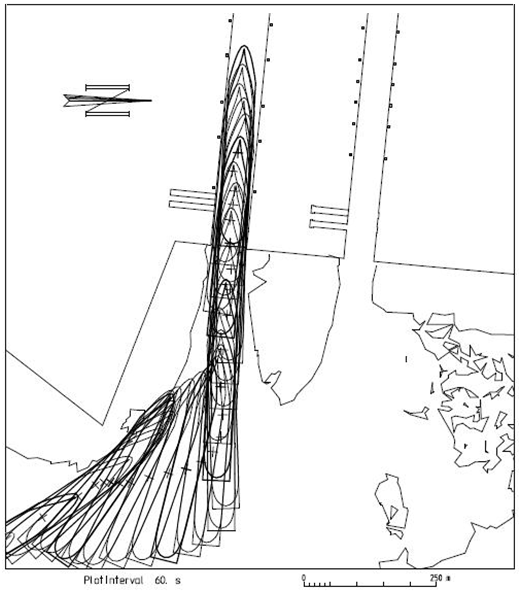
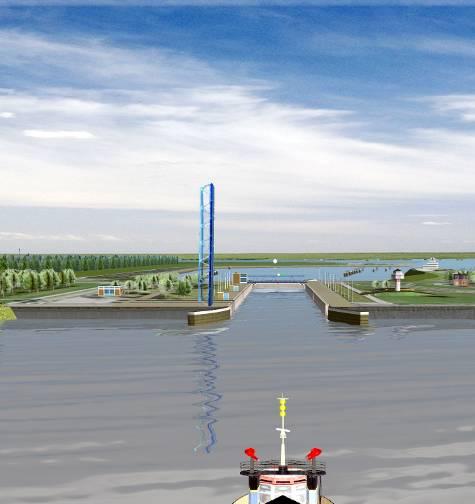
Example
An example of such a study is the arrival and departure regulation for 8000 and more TEU container ships with a maximum draught of 145 dm.
Location
Notice to Mariners 02-2005 mentions that from September 2005 on the arrival and departure for container ships with a length from 340 m up to a maximum of 360 m is regulated. Container ships having the mentioned length can only have the respective draughts of 140 dm and 130 dm. Shipping companies were however, on their request, granted exceptional exemptions on the base of which some large container ships departed with a draught of 135dm.
To examine the influence of the new generation of container ships, with lengths exceeding 360 m, on shipping traffic on the Western Scheldt, the Shipping and Assistance Services requested research to scientifically validate a new arrival and departure regulation.
Research
The dimensions of the examined container ships were selected in accordance with the maximum size of existing or planned container ships. The dimensions of these vessels are:
| 8400 TEU | 11400 TEU | 13230 TEU | 14000 TEU | |
|---|---|---|---|---|
| LOA | 352.0 m | 365.5 m | 381.0 m | 397.6 m |
| LPP | 331.8 m | 349.5 m | 362.4 m | 376.0 m |
| B | 42.8 m | 48.4 m | 51.0 m | 56.4 m |
| T1 | 12.2 m | 12.8 m | 13.1 m | 13.1 m |
| T2 | 14.6 m | 15.4 m | 16.0 m | 16.6 m |
The Western Scheldt is a winding river characterized by a limited water depth and a limited width. Predicting the behaviour of the container ships on the river required the setup of an extensive mathematical modelling which takes the phenomena given below into account:
- Manoeuvring behaviour in open water with an under keel clearance varying from 10% to 100% of the vessel's draught
- The influence of banks on the manoeuvring behaviour
- The influence of the interaction with other vessels on the manoeuvring behaviour
Apart from the influence of the restricted sailing environment on the manoeuvring characteristics, squat also plays a significant role in the accessibility for large container ships. Squat is the sinking and trimming of the vessel under the influence of the disturbance caused by its sailing speed in surrounding water. If a vessel sails in very shallow water, then this extra sinking may be responsible for bottom touching or serious vibrations may occur.
Within the scope of the study extensive research of squat was performed focussing on the effect of the below-mentioned parameters:
- Forward speed through the water
- Propeller action
- Transverse speed through the water
- Yaw rate
- Other shipping traffic
- Banks
The models for squat and manoeuvring behaviour in confined waters were implemented into the mathematical model of the ship manoeuvring simulators.
Evaluation
The accessibility for the examined container ships was evaluated on the basis of real-time simulations carried out on both ship manoeuvring simulators, SIM360+ and SIM225. During these simulations, the most difficult scenarios were simulated as prescribed by the Steering Committee. It concerned head on encounters between two large container ships at three unfavourable locations on the Scheldt by a maximum ebb current and maximum flood current. Both the approaching as well as the departing container ship, were steered by pilots on a separate simulator bridge for which a coupling of both simulators was necessary.
This required ten simulation days, with 112 encounters carried out in six different situations (3 locations by 2 current situations). For each of these situations, the encounters could be evaluated on the basis of the lateral distance kept during the encounters and the distance kept by both vessels up to the line of buoys.
Results
From the research that was carried out, preconditions could be formulated connected to the arrival of larger container ships to the port of Antwerp. Accordingly, encounters with large vessels at some locations turned out to be unrecommendable and valuable data were obtained regarding the squat with large container ships. Moreover, it appeared that the approach or departure with relevant container ships should be carried out in an expedient manner and that also the other shipping traffic is required to be attuned to these container ships. More extensive research (amongst other things, by low water conditions) is required to supplement this research.
For more information:
Eloot, K.; Verwilligen, J.; Vantorre, M. (2010). Synergy between theory and practice for Ultra Large Container ships, in: 32nd PIANC Congress, 125th anniversary PIANC - setting the course, Liverpool, UK, Liverpool Arena and Convention Centre, 10 - 14 May 2010: PIANC MMX papers. pp. [1-13]

